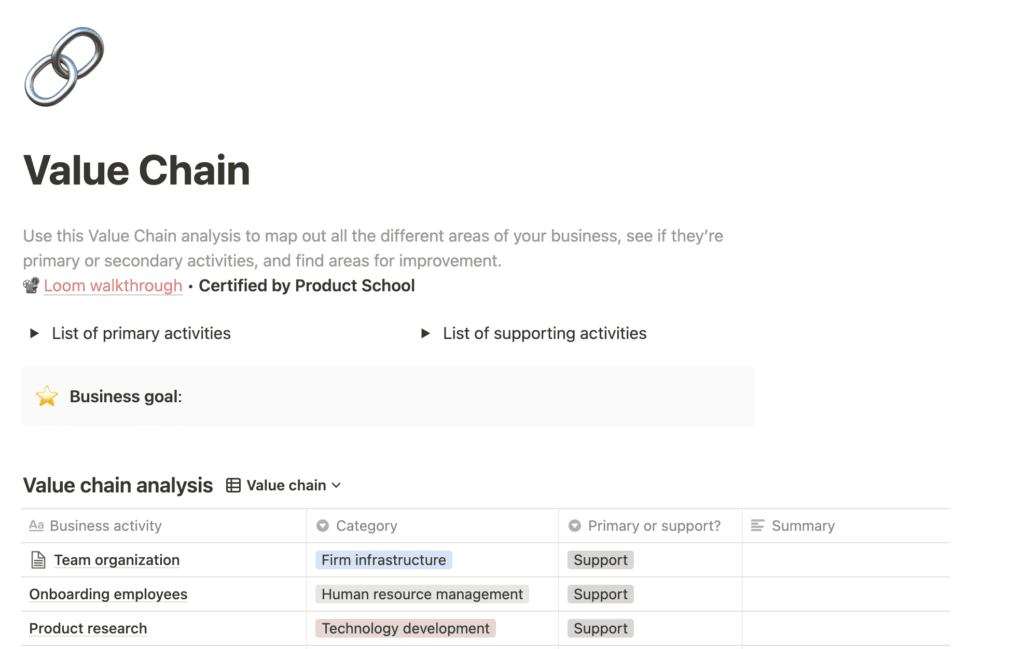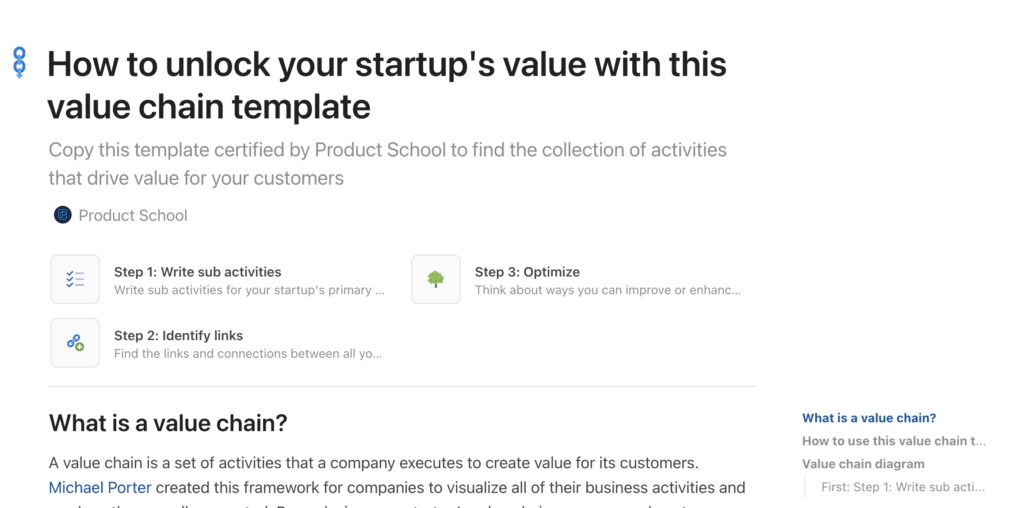Updated: September 9, 2025- 8 min read
In his 1985 book Competitive Advantage, renowned economist Michael Porter laid out his value chain model, a method of analyzing how an organization creates value. So why do we still care about this 35-year-old method today?
As per the title of his book, Porter believed that optimizing your value chain can help you define and maximize your competitive advantage. This method remains relevant because it sees value creation as a system; though some inputs and outputs have changed over the years and transformation processes have advanced, the need to understand how the relationship between input, transformation, and output creates value has not.

It’s a great breakdown to understand how your organization takes inputs and transforms them into outputs in a profitable way. Doing a value chain analysis is like conducting an audit on your value creation processes, and uncovering areas where you can create even more value. The first step: identifying the links in the chain.
Two Types Of Functions
There are two types of functions in Porter’s Value Chain: primary and supporting.
Primary and support activities are interconnected, building upon each other to create value. The more these activities are optimized, the greater the profit margin, and the greater the competitive advantage.

The primary functions are the processes and activities that are directly related to the creation, sale, and maintenance of a product or service. And the supporting functions support the primary ones.
Primary Functions
The 5 primary functions are:
Inbound logistics
Operations/Production
Outbound logistics
Marketing/Sales
Service
Inbound logistics

Processes, relationships, and activities related to the inputs you receive.
These inputs are the basic ingredients of a product or service. They may be raw materials, physical goods, or something less tangible like data or hireable talent; the inbound logistics processes are thus related to receiving, storing, and distributing these inputs internally.
Developing strong supplier relationships and having effective internal organization is a great way to add more value here.
Operations/Production
These are the processes and activities that transform inputs into outputs: converting what you received through inbound logistics into a finished product or service that you can then sell to customers. In physical production, this would include assembly and final packaging. For digital products, this could be your engineering and design processes; for educational tools, this also includes curating and creating informational content.
Here, the value comes from the operation and production systems in place. To add value here, reduce friction wherever possible in the transitions that convert input to output, or find new processes or features that make the end product more valuable.
Outbound logistics
The activities that allow you to deliver your product or service to your customer, including storage, distribution, and transport. These outbound logistics processes can involve both internal (the UX of your website’s checkout experience) and external elements (the email distribution software your company uses, integration into the App Store or Google Play, etc).
Ask yourself: where do you store your finished product? How are you delivering it to your customer (i.e. via app, email, or internet browser)? Even if you don’t ship a physical product, you still have to process customer orders, distribute your software, and determine the legal, financial, and technical logistics of doing so.
Marketing and Sales
These are processes of persuasion and communication, including any strategy you use to raise visibility and target appropriate customers. These activities can be quite varied, but all are extremely important; this is your time to communicate all of the value you’ll bring to them—the same value you’ve been building throughout the entire value chain.
The value you add here to your customer is clarity and information about your product or service, as well as assistance in making a purchase. To increase this value, ensure your customer targeting is specific and relevant, and make sure your marketing and sales team are aligned in their messaging, with a full understanding of the product value.
Building strong customer relationships is also a key way to add value here; customers will feel happier with their purchase if they feel they can trust the company and the product. In the best cases, marketing can make customers feel like they’re part of a community, meaning they’re not just gaining access to a product or service, but to a group of like-minded people.

Service
Service processes work to maintain the value and trust built-in marketing and sales. They kick in after a sale is complete. These activities include installation, repair, refunds, exchanges, and customer service. Because digital products are so often iterative, complaints and bugs uncovered in the service processes can feedback into inbound logistics as customer experience data that your company can use to make the next update or product even better (and creating more value in the longterm!).
Secondary Functions
The 4 secondary functions are:
Procurement
Human Resource Management
Technological development
Infrastructure
Procurement
Activities and strategies your organization undertakes to get the resources it needs to operate. Oftentimes these are the methods used to secure the inputs received in inbound logistics processes, but it also includes processes to procure supports needed for all primary activities.
Examples of activities are the research and purchase of new software to use for marketing, price negotiation, and entering into and managing relationships with suppliers.
Resources can quickly become expensive, and this cost is passed along to consumers. The trick here is finding a balance between affordability and quality. Procurement tends to greatly reduce profit margin, so it’s worthwhile reexamining if there’s any way to reduce costs in this area of the value chain.
Human Resource Management
Team members are a hugely important source of value; having high-quality workers increases the value of all your other activities and can create a competitive advantage.
All activities related to hiring, training, compensating, motivating, retaining, and dismissing workers fall into Human Resource Management processes. There are plenty of ways to increase value here, from introducing HR management technologies, to hiring excellent recruiters, to incorporating employee feedback into company culture.
Technological development
Processes to do with internally developing or finding externally-developed technology that increase value; the hardware, software, and strategic technological knowledge you use.
Value here comes from innovation and optimization, finding new things that add value, or doing old things better. Reducing information and technology costs, reducing technical debt, using technology to streamline other functions, and staying up to date with current technological advances are excellent ways to create value here.
Infrastructure
The support systems that allow a company to function on the day-to-day. This is where accounting, legal, administrative, and financial operations come into play.
These processes may or may not directly support the other functions, but keep the company running so that the primary and support functions can take place. Financial planning, fostering relationships with investors, and refining management practices are all examples of increasing value at this level.
Analyzing the Links
Now that you’ve defined the links in your value chain, it’s time to figure out how they’re connected, and which links could do with some strengthening.
Step 1—Identify Subactivities
Subactivities are the type of activities within the primary and supporting functions. There are three categories of subactivities:
Direct activities: activities that create value
Indirect activities: ensure direct activities run smoothly
Quality assurance activities: ensure that direct and indirect activities meet the necessary standards
From here, take your list of primary and supporting activities and break them down one by one to determine which category they fall into.
Step 2—Make Connections
You’ve now identified your value activities and what role they have in creating value. It’s time to map out how they influence each other. For instance, there’s a link between email automation after purchase and customer service requests; another between selecting data storage software and conducting user research.
Step 3—Find Value-Enhancing Opportunities
With a clear picture of how your value activities work together, you can begin to focus on specific connections. Some valuable connections might be easy to scale up. Prioritize and make sure they align with your company strategy.
Get Your Template
Now that you know what a Value Chain is, you have template options. Do you prefer something classic like Google Sheets, or will you branch out to other cool organizational and collaborative tools like Notion, Coda, and MURAL?
On Google Drive
Complete the above exercise following this template!
On Notion
Notion is an all-in-one workspace where you can create anything from a to-do list, to a product roadmap, to a Value Chain analysis.

On Coda
Coda is way to build docs for teams that brings together words and data. It’s a different way to organize and collaborate. Try it out!

Need more templates?
Still looking for some great templates? Check out our collection of Product Management Templates.
Updated: September 9, 2025





